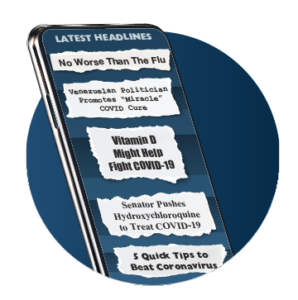“Total burnout,” said one colleague of mine while stepping out of a patient’s room, moments after being lectured on “COVID being a complete hoax.” Meanwhile next door, an elderly patient was gasping for air on a BiPAP machine with no family in sight to say goodbye.
We are seeing it play out everywhere: medical disinformation and its rapid spread, like wildfire, across the political landscape. Social media is propagating inaccuracies as our patients easily drown in the sea of disinformation. “Is this true?” is common from friends and family encountering COVID-19 content online.
The stakes are high. A recent study found a correlation between the magnitude of individual fears for COVID-19 and the likelihood of spreading false or misleading information, accepting unverified information, and believing untrue existential statements.1 The United States Centers for Disease Control and Prevention has published reports illustrating the magnitude of medical myths and misinformation. Worse health outcomes have been associated with lies pertaining to COVID-19.
We’ve been here before. Disadvantaged populations have historically suffered far worse than others during previous outbreaks. During the early 2000s, AIDS denialism offset early recognition of HIV being the etiology of AIDS in South Africa, which directly contributed to 330,000 preventable deaths, according to one recent study.3 Mistrust can also lead to denialism, as seen by HIV-related “conspiracy beliefs” that include theories of purposeful U.S. federal government action to disseminate HIV as a form of genocide against people of color (among other harmful theories).4
Today, we should all be working hard to connect with populations who are especially vulnerable to COVID-19 and medical misinformation. We must simultaneously fight vaccine hesitancy and extinguish the flames of hoaxes, anti-mask myths, and other conspiracy theories that have run rampant over the past year. Thankfully, we have several weapons available to us, ranging from useful resources to new strategies.
Our Tools
There are quick, simple, and effective ways of verifying information online. For example, the nonpartisan RAND Corporation offers numerous tools on its website. RAND’s website offers a YouTube data viewer that verifies the authenticity of video content, Internet browser extensions that detect manipulation (“Did Dr. Fauci really say that?”), and mobile apps. Some of its other tools can be used as fact checkers for social media. One offering is the Bot Sentinel (https://botsentinel.com), a free platform that identifies troll bots and untrustworthy accounts on Twitter by using a manual process for classifying some accounts as “problematic” and others as “normal.”
Social media can be a solution, not just a problem. Properly used, online platforms can be a powerful way to reach people—they are easy, innovative, and ubiquitous but rife with potholes and medical disinformation.6 With the proper tools, we can verify content for accuracy that aligns with our medical expertise. Perhaps the best way that emergency physicians can fight medical misinformation on social media is to flood the major hubs, be it Facebook, Twitter, Instagram, or TikTok, with reliable, factual, evidence-based information. To that end, many medical organizations have made headway by leveraging social media, and even some superstars in emergency medicine can make a difference.7,8
And it’s not just about the public. We can also help educate our colleagues who may not have the bandwidth to keep up with the latest research. Unfortunately, we’ve got work to do if we are going to avoid reports like one appearing in January stating that “around 30 percent of eligible medical workers” have refused the vaccine in New York.9
Pages: 1 2 3 | Single Page






No Responses to “Fighting Medical Misinformation Is Our Lane Now”